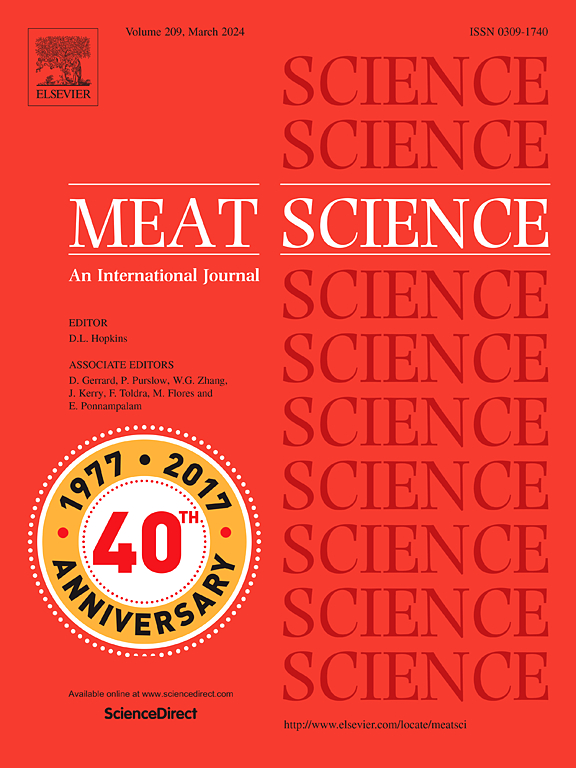使用双能x线吸收仪预测猪里脊排的总脂肪和肌内脂肪
IF 6.1
1区 农林科学
Q1 Agricultural and Biological Sciences
引用次数: 0
摘要
本研究评价了双能x线吸收法(DXA)测定猪排中总脂肪和肌内脂肪(IMF)的有效性,以化学分析为金标准参比,在有和没有皮下脂肪(SF)的样品中。在所有样品中,DXA脂肪百分比与化学测定的脂肪含量有很强的相关性(r = 0.91)。然而,当单独分析有和没有SF的样品时,相关性减弱,有SF的样品中总脂肪与IMF的相关性中等(r = 0.69),而没有SF的样品中DXA脂肪百分比与IMF的相关性较弱(r = 0.23)。从DXA脂肪百分比预测总脂肪含量的回归模型应用于合并数据时表现出最高的预测性能(R2 = 0.83, RMSECV = 3.22%,斜率= 0.97,偏差= 7.55%)。相比之下,IMF预测模型的预测能力较差(R2 = 0.05, RMSECV = 0.89%,斜率= 0.14,偏差= 7.61%)。这些发现表明,虽然DXA对估算猪排中的总脂肪含量有效,但其准确预测IMF的能力有限。为了提高DXA对猪排中IMF定量的可靠性,需要进一步的校准和模型改进。本文章由计算机程序翻译,如有差异,请以英文原文为准。
The use of dual-energy X-ray absorptiometry for predicting total and intramuscular fat in pork loin chops
This study evaluated the efficacy of dual-energy X-ray absorptiometry (DXA) in determining total fat and intramuscular fat (IMF) in pork chops, using chemical analysis as the gold-standard reference, in samples with and without subcutaneous fat (SF). Across all samples, DXA fat percentage showed a strong correlation with chemically determined fat content (r = 0.91). However, when samples with and without SF were analyzed separately, the correlations weakened, with a moderate correlation observed for total fat in chops with SF (r = 0.69) and a weak correlation between DXA fat percentage and IMF in samples without SF (r = 0.23). The regression model for predicting total fat content from DXA fat percentage exhibited the highest predictive performance when applied to pooled data (R2 = 0.83, RMSECV = 3.22 %, slope = 0.97, bias = 7.55 %). In contrast, the model for IMF prediction demonstrated poor predictive capability (R2 = 0.05, RMSECV = 0.89 %, slope = 0.14, bias = 7.61 %). These findings suggest that while DXA is effective for estimating total fat content in pork chops, its ability to accurately predict IMF is limited. Further calibration and model refinement are necessary to enhance DXA's reliability for IMF quantification in pork chops.
求助全文
通过发布文献求助,成功后即可免费获取论文全文。
去求助
来源期刊

Meat Science
工程技术-食品科技
CiteScore
12.60
自引率
9.90%
发文量
282
审稿时长
60 days
期刊介绍:
The aim of Meat Science is to serve as a suitable platform for the dissemination of interdisciplinary and international knowledge on all factors influencing the properties of meat. While the journal primarily focuses on the flesh of mammals, contributions related to poultry will be considered if they enhance the overall understanding of the relationship between muscle nature and meat quality post mortem. Additionally, papers on large birds (e.g., emus, ostriches) as well as wild-captured mammals and crocodiles will be welcomed.
 求助内容:
求助内容: 应助结果提醒方式:
应助结果提醒方式:


